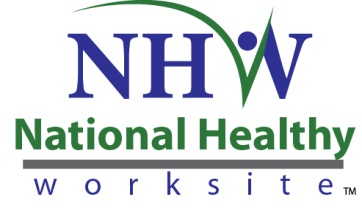Attachment_D-1_NHWP Eligibility Requirements
Attachment_D-1_NHWP Eligibility Requirements.docx
National Healthy Worksite Program
Attachment_D-1_NHWP Eligibility Requirements
OMB: 0920-0965
Eligibility Requirements
for Employer Participation in the National Healthy Worksite Program



The National Healthy Worksite Program is open to public and private employers with 1000* or less full-time employees that meet the following requirements:
1. The employer is located in one of the eight site locations:;
a. Region 1: Somerset County, ME; and Philadelphia County, PA
b. Region 2: Shelby County, TN
c. Region 3: Marion County, IN
d. Region 4: Harris County, TX
e. Region 5: Buchanan County, MO
f. Region 6: Kern County, CA
g. Region 7: Pierce County, WA
*Note: Employers in excess of 1000 full-time employees interested in participating may nominate a specific worksite not exceeding 1000 employees. This worksite must represent an independent business or autonomous organizational unit within the larger company with the ability to set local policies and procedures without prior approval such as the ability to institute a tobacco-free campus policy or negotiate local food vending contracts.
2. The employer submitted a completed application during the open certification period (January 20 – April 15, 2012) at http://www.cdc.gov/nationalhealthyworksite/eligibility-requirements.htm;
3. The employer offers health insurance to all eligible employees and covers all or part of the following medical services after the deductible / co-pay is met:
a. Preventive care (preventive office visits, preventive lab and x-ray, pap smear and mammography, flu and pneumonia immunizations, endoscopic services including but not limited to colonoscopy).
b. Physician Services (office visits, diagnostic lab and x-ray, allergy testing, injections [including allergy], inpatient and outpatient services, surgery, emergency room visits).
c. Mental Health, chemical and alcohol dependency (inpatient services, outpatient and office therapy sessions).
4. The employer leadership will commit to the following:
a. Serve as role models/champion for healthy lifestyle behaviors as evidenced by their program participation and engagement.
b. Allow employees to participate in employer-sponsored workplace health programming during work hours.
c. Adopt and implement health protection and promotion programs, policies, and supports to foster a healthy, safe work environment.
d. Participate in data collection activities.
5. The employer will fully participate in technical assistance and training sessions.
6. The employer will become an active participant in a network of National Healthy Worksites.
7. The employer will become an active participant in community coalitions and partnerships.
8. The employer is an independent business or autonomous unit of a larger organization, as demonstrated by the ability to set local policies and procedures without prior approval such as the ability to institute a tobacco-free campus policy or negotiate local food vending contracts.
9. The employer currently does not have a comprehensive wellness program^ in place (not including an employee assistance program [EAP] or standard wellness benefits or programs included in health plan), defined as having 50% or less of the following interventions in place within each of the five subcomponents (programs, policies, environmental support, worksite infrastructure, assessment and evaluation) listed below during the last 12 months.
Employers with more than 50% of the interventions selected in each subcategory will not be eligible. Preference will be given to employers who identify the fewest number of interventions present in each subcategory and overall.
^ A comprehensive wellness program refers to a coordinated and comprehensive set of strategies which include programs, policies, benefits, environmental supports, and links to the surrounding community designed to meet the health and safety needs of all employees.
a. Programs ( 50% or less)
i. Classes or seminars on fitness, nutrition, tobacco cessation or stress management.
ii. Weight management programs that offer counseling or coaching.
iii. Physical activity classes or walking groups/clubs.
iv. Tobacco cessation counseling through a quitline or health plan.
v. Healthy Lifestyle coaching or counseling.
vi. Signage related to health promotion program components.
vii. Information resources such as brochures, videos, posters, pamphlets, newsletters, or other information addressing the risks of physical inactivity, poor nutrition, and/or tobacco use.
b. Policies (50% or less)
i. A tobacco-free campus policy.
ii. A policy that healthy foods will be made available at all company meetings or functions where food is served.
iii. A food procurement policy that limits company purchase of food and beverages high in sodium, calories, transfats, or saturated fats.
iv. A policy allowing employees work time or flextime (i.e., flexible scheduling) to engage in employer-sponsored workplace health program activities.
c. Environmental Support (50% or less)
i. Access to onsite or nearby fitness facilities.
ii. Worksite stairwell enhancement and promotion.
iii. Making healthy foods available and accessible through vending machines or cafeterias.
iv. Menu labeling / signage including nutritional information on calories, sodium, transfats, and saturated fats.
v. Providing employees with food preparation and storage facilities such as a microwave ovens, sinks, refrigerators, and/or kitchens.
vi. An onsite Farmer’s Market.
vii. Environmental supports for recreation and exercise such as establishing walking/running trails; utilizing multi-purpose space for physical activity classes, maps of suitable walking routes, bicycle racks, open space designated for recreation or exercise, a shower and changing facility.
viii. A work environment free of recognized health and safety threats.
d. Worksite Infrastructure (50% or less)
i. Existing workplace health council or committee.
ii. Existing site-level health promotion champions.
iii. Existing workplace health improvement plan.
iv. Promote and market health promotion programs to employees (e.g., use multiple channels of communication, send frequent messages).
v. Participation in a community health coalition.
e. Assessment and Evaluation (50% or less)
i. Conduct voluntary employee health risk appraisals/assessments through vendors, onsite staff, or health plans and provide individual feedback (e.g., written report, letter, one-on-one counseling) to employees.
ii. Conduct an employee needs and interests assessment (e.g., focus groups, employee surveys) for health promotion and provide feedback to workers.
iii. Conduct ongoing evaluations of health promotion programming that use multiple data sources (e.g., employee health risks, aggregate medical claims, employee satisfaction or organizational climate surveys, or other relevant data).
10. Participation in a telephone interview during the final selection process.
Additionally, for the largest employers of 500-1000 full-time employees:
A commitment to invest $50,000 over two years to health promotion programming;
Employers in excess of 1000 full-time employees interested in participating may nominate a specific worksite not exceeding 1000 employees. This worksite must represent an independent business or autonomous organizational unit within the larger organization with the ability to set local policies and procedures without prior approval such as the ability to institute a tobacco-free campus policy or negotiate local food vending contracts.
Preference will be given to interested employers who indicate:
Financial stability.
No plans for acquisition, senior leadership turnover, or company sale for the duration of the project.
U.S./Domestic company.
Demonstrated health need including high employee rates of obesity, tobacco use, diabetes or other chronic conditions.
| File Type | application/vnd.openxmlformats-officedocument.wordprocessingml.document |
| Author | Lang, Jason (CDC/ONDIEH/NCCDPHP) |
| File Modified | 0000-00-00 |
| File Created | 2021-01-29 |
© 2026 OMB.report | Privacy Policy